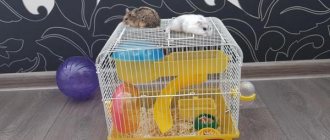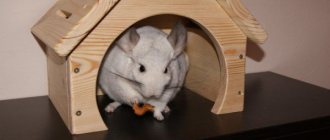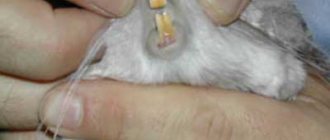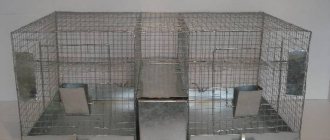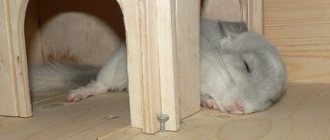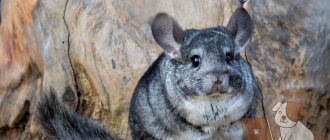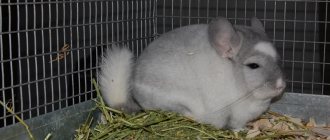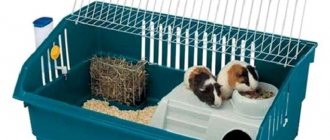Basic requirements for cells
Choosing a cage for rodents is not the easiest thing. The stores offer a large selection, but not all of the products presented meet the necessary requirements. The first thing you should pay attention to when purchasing is the size. Chinchillas are active animals and need constant movement. Too cramped housing, even with daily walking, will lead to the development of various bad habits and health problems.
Ideally, a chinchilla cage should have a minimum size of 100 cm by 60 cm by 80 cm.
An important issue is the material from which the pet’s housing is made. Chinchillas are rodents and will try everything, so it is necessary that the material of both the home itself and everything inside is strong enough and safe. It is better to give preference to hard plastic and metal. Another important point is the distance between the twigs. The skeleton of a rodent is very mobile and in nature they are able to squeeze through even very narrow cracks. To prevent your furry pet from running away one day, the recommended distance between the twigs is no more than one and a half centimeters. If you plan to keep a chinchilla family, then there should be no more than eight millimeters between the twigs.
The next important point is ventilation. Fresh air should flow freely and in large quantities into the pet’s home.
A large cage will allow you to diversify the animal’s everyday life with various toys: ladders, shelves, manholes, tunnels and labyrinths, running wheels and ropes. In addition to toys, drinkers and feeders, you should definitely install a bath with sand and a tray with wood pellets, which the animals will use as a toilet.
And one more point - safety. The housing itself and all accessories must be made of sufficiently durable material and not contain traces of paint, glue, artificial textiles, lime and other harmful and dangerous components. It is inevitable that the chinchilla will start gnawing everything. And the entry of toxic substances into the esophagus will cause severe poisoning.
Construction
We start after purchasing materials. If you are making a cage at home, then equip and prepare the place in advance. A sufficient amount of light is necessary, as the work will take a lot of time.
We create a drawing of our cell and transfer the dimensions there. Do not rush to cut out parts; it is better to check all the measurements several times.You can watch different videos on how to make a cage for chinchillas to have an accurate idea of the work ahead.
We cut out a rectangle from this material to size - this is the future base of the cell. It must be covered with clapboard or a plywood sheet on top.
Check it out here too!
- Do-it-yourself trolley - how and from what to build a decorative and tool trolley (135 photos and videos)
DIY nests for laying hens: drawings, tricks, best solutions and tips on how to make nests correctly (115 photos and videos)
How to hem felt boots with your own hands: materials, tools, useful tips for hemming. Step-by-step instructions with photos + master class with video!
We install a removable tray on the base. If you decided in advance that it will not be there, you need to treat the material with water-repellent substances. Because chinchillas will go to the toilet and water may spill from the drinking bowl.
We vertically fasten the bars with self-tapping screws, ties or nails to the base in the corners. This way we will create the frame of our cell.
The top of the frame is done in exactly the same way. You can install an additional horizontal belt. This will strengthen the structure and help create additional shelves.
Metal rods or mesh are stretched over the frame. We fix it with nails or screws to the base. Make sure that there are no sharp protrusions sticking out anywhere that could injure the animal. To do this, you can install a metal strip.
Cleaning will be easy if you have several doors and a top that can be removed. We fasten the doors with hinges purchased at the store. We make frames from lining.
If the building has several floors, it becomes necessary to place stairs between floors. It will be much more fun and interesting for the animal to live in a house equipped with various loopholes and labyrinths.
Use your imagination when creating these things, but don't make them too small. Otherwise, you will have to destroy your product while rescuing the stuck animal.
Chinchillas are very sensitive rodents and even a small draft can provoke illness. To prevent this from happening, we cover two adjacent walls with wood. It is better to place the cage approximately 50 cm from the floor.
You can make a convenient shelf or frame. It may contain toys and care products. Do not install it near furniture or interior items. The animal can spoil them
We buy treatment products from construction or pet stores. You need to coat the inside with the solution to ensure that your chinchilla has an antibacterial living environment.
The outer part of the structure is varnished or painted. These are important measures to protect metal from corrosion and wood from rotting.
After reading our article, you can understand that it is not at all difficult to build a cage for a chinchilla with your own hands.
Main types of cells
There are several types of cages for chinchillas, and when choosing one of them, you should know not only the pros, but also the cons.
Ordinary cell
These are the cages for rodents that are sold in all pet stores.
Pros:
- Availability,
- Possibility to choose color, size,
- Collapsible,
- Easy to clean.
Minuses:
- Poor sound insulation (chinchillas are nocturnal animals and at dusk they begin active games, fussing and running around, which interferes with sleep),
- Hay, sawdust, fluff and pieces of food fly in all directions,
- The plastic parts of the cage will quickly become unusable,
- Some breeders find it difficult to fit the cage into the interior of the room.
Wooden showcase
The display cage for the chinchilla is made to order from plywood, furniture board or wood.
Pros:
- Economical. Often such a cage is made independently from old cabinets,
- Good sound insulation,
- Large area for the animal
- The ability to fit a rodent house into the interior,
- Aesthetic appearance.
Minuses:
- Difficulty in disinfection and the possibility of odor formation due to poor cleaning,
- If the walls are made of mesh, feed, sand, sawdust, hay will be scattered around,
- Inability to disassemble the structure,
- Fragility.
Professional display for chinchillas
Such a showcase is made not only from wood and chipboard, but also glass and aluminum. Such display cases are usually used by professional breeders. Pros:
- Safety,
- Good sound insulation,
- Possibility to design a showcase taking into account the interior of the apartment,
- Choose the optimal size,
- Ease of cleaning,
- Durability,
- The ability to constantly observe the animal through glass doors.
Cons: Quite expensive. The minimum cost of a small showcase starts from 9,000 rubles. The second disadvantage is that it is not always possible to find a craftsman who understands such designs and can make a high-quality and reliable display case.
Farm cage
Farm cages (for pair, family or polygamous breeding of chinchillas) are not used for home keeping. They are made of metal, attached to walls or installed in several tiers. Used on farms.
Do-it-yourself housing for a chinchilla
Often breeders decide to make a chinchilla cage with their own hands.
If you have a desire to tinker, then here are a few instructions to help you. First, buy the necessary materials for the job. It is better to give preference to wood. The frame will be made of bars, lining, boards and many shelves. Chipboard or plywood are also suitable. To close the holes, you need a metal mesh.
The following tools will be useful:
- hacksaw;
- jigsaw;
- hammer;
- drill and wood bits;
- stationery knife, marker;
- metal scissors;
- ruler.
To begin, prepare a drawing, taking into account the size of your room and the size of the desired pet house. Then start making the base, which needs to be covered with clapboard.
Next, the cage frame is built from the bars.
The bars are attached to the corners of the base using self-tapping screws or nails.
Using a metal mesh, the walls of the cage and its roof are tightened.
To make cleaning easier, we recommend making several doors on different sides.
Then you can install various shelves and place the accessories your animal needs on them.
It is best to cover the back of the cage with a sheet of plywood.
Finally, it is necessary to treat the house with a protective impregnation.
If you show your imagination, you can use old furniture and other available materials. An old cabinet is often used:
- The doors are removed from the furniture and the inside is repurposed for animals. Some of the shelves are cut out to allow animals to move freely.
- You need to cut a hole in the top of the closet and stretch the mesh so that the house is ventilated.
- In place of the cabinet doors, you can make frames from wood and tighten them with a metal mesh.
A do-it-yourself chinchilla display “from scratch” will require a little more time and skill.
So, you will need:
- metal tubes for the frame, or wooden yards;
- corners to connect parts;
- cogs;
- metal mesh;
- door hinges.
Then follow the instructions step by step:
| Step | Description |
| 1. | First you need to prepare drawings, taking into account the minimum acceptable dimensions for a chinchilla cage. |
| 2. | Next, we assemble the frame from pipes and yards, using corners for reliability, and fasten them with screws. |
| 3. | Make (internal) markings, designating areas for the animal’s life, that is, think about a place for sleeping, playing, toilet, bath, etc. |
| 4. | The mesh bottom is attached to the cage frame. For this you need a welding machine. |
| 5. | Connect the frame and walls of the house. |
| 6. | Next you need to install the door, use hinges and a lock. |
| 7. | Attach accessories inside the house. |
A do-it-yourself corner display case for a chinchilla is quite popular, because it can significantly save space in your apartment. To make one, show a little imagination and dexterity, and the result will definitely please you!
Where to place a chinchilla cage
Take seriously the choice of place in the apartment where the cage with the animal will be placed. It is better not to change the location of the cage throughout the animal’s life.
Here are some tips for you:
- the room should be dry and light;
- direct rays of the sun should not enter the cage;
- drafts should not be allowed;
- the air temperature where the animal lives should not exceed +23° C.
- the cage should not be placed next to electrical heating appliances;
- It is not advisable to place the cage on the floor;
- the cage should not be placed next to loud devices (equipment);
- Since chinchillas are very active at night, you should not place the cage in the bedroom. It's better to put it in the living room.
Cleaning a chinchilla's cage or display case
It is not enough to simply make a house, choose a place for it and move your pet into it; you must also not forget about caring for your pet’s home. Once a week you need to do a general cleaning, and at this time the animal should be placed in a carrier. The house can be wiped with a wet cloth and even vacuumed. At the end of cleaning, you need to wipe the cage dry. Disinfection (if necessary) is carried out using specialized products purchased at a pet store.
Chinchilla display
Display cages are the most preferred and convenient option for keeping a chinchilla. They are distinguished by their large size, tiered design and the ability to contain several animals in one display case at once. The size of the enclosure is determined only by the capabilities of the owner and the size of the room where it will be installed.
Most often, display enclosures are made of wood. The material is not only safe, but also noble - such a showcase will fit well into the interior of the room. However, a wooden showcase requires some care - keeping it clean is somewhat more difficult, since wood absorbs odors and moisture well. The second popular material for display cases is chipboard sheets.
A chipboard display will cost much less than a wooden one. However, when choosing sheets, you should be sure of their safety: some impregnations are very poisonous. Showcases are also made from aluminum profiles. This version of the display case will be the most expensive (from 9 thousand rubles), but will last a long time.
The latest version of the display case is made from old unnecessary cabinets and pencil cases. Many breeders prefer this option. There are several reasons for this - price, availability of material, convenience. Making a display case from an old cabinet means cutting several windows in the side walls, attaching a lock to the doors and arranging the interior space. If a breeder’s goal is to breed chinchillas, then it is better to use a display case.
Tools and materials
Before you begin construction, you need to select the material to create the cage. Wood is best suited for this, as it is a pure biological material. It is also easy to process.
All sorts of sticks and small boards will not be lost. They can fit perfectly into the animal’s play area.We cover the frame with rods or mesh with small cells. We paint it well so that corrosion does not occur, and the house will serve you for many years.
Read here - How to hem felt boots with your own hands: materials, tools, useful tips for hemming. Step-by-step instructions with photos + master class with video!
We will build the cage using metalworking tools:
A drill will help you drill or connect wood together. Also, for its full operation, drills are needed.
To cut wood, do not forget a saw - a hacksaw.
Check it out here too!
Do-it-yourself barbecue from a gas cylinder: step-by-step instructions, choosing the optimal sizes and tips for choosing projects (110 photos)Do-it-yourself winter chicken coop: design, layout, insulation, heating. 80 photos of warm chicken coops
How to make a snow blower with your own hands: manufacturing methods, diagrams, drawings, construction options and application nuances (100 photos + video)
Nailing nails of different sizes is done with a hammer. It's also worth taking for work.
To make the product as even as possible, we help ourselves with a level. All measurements are taken with a ruler.
You can mark dimensions on the material with a pencil or marker. A utility knife can also be useful for small work activities.To make your work easier, take a jigsaw. If you don’t have it because you don’t need it, it is advisable to ask your neighbors or friends so as not to spend extra money.
Cutting out metal parts is carried out with special scissors.
For a new design, it is better to purchase locks, latches and hinges in hardware stores to be sure of their strength and your animal cannot get free.
Check it out here too!
How to make a pump with your own hands - step-by-step manufacturing of a pump and options for making simple and effective pumps (95 photos + video)Do-it-yourself hot smoked smokehouse: 100 photos, review of the best drawings, project selection and construction options
- How to make a cage for a parrot: basic requirements, tools and materials, step-by-step photo instructions. Tips from experts on arranging a cage
Pull-out shelves, all kinds of wheels and various metal hinges - you need to stock up on everything you need. But we make the chinchilla cage itself with our own hands.
Ordinary cell
In small apartments, chinchillas are most often kept in ordinary cages. It is best to choose the largest possible housing for your pet - after all, the animal will spend most of its life in it. However, if the breeder has enough time for daily communication with the animal, the chinchilla can be kept in a small house.
Lori cells
A good option for keeping one chinchilla would be the Lori cage model 5363. Its average price, depending on the region, starts from 1,400 rubles. Dimensions: 56 cm by 40 cm by 85 cm. You can install two shelves or a shelf and a house in it. There is also enough space for a feeder and drinking bowls, but the bathing area will have to be installed temporarily.
The same manufacturer has a more convenient and practical model: Lori Chinchilla 100. The price starts from 2,400 rubles. Dimensions: 108x56x94 cm. The cage is quite spacious and allows you to place inside not only a house, but also shelves and some toys. Can be used to keep a pair of chinchillas.
Waka Cells
Another good cell manufacturer is Vaca. One of the most popular models, Vaka 515, has dimensions of 515x575x660 mm, and the price starts from 3,300 rubles. It conveniently houses shelves, feeders, toys and a bathing suit. You can keep a couple of animals.
Cage Creed
If funds allow, you can purchase a cage from Kredo for chinchillas in three tiers. Its price starts from 5,000 rubles. Dimensions 65x45x93 cm. This cage is also suitable for keeping several chinchillas.
Regardless of the company and price, all ordinary cages have a plastic base with a pull-out tray and metal bars.
The main difference is the quality of metal and plastic. Which model is better depends on personal preferences and financial capabilities. There is no one common and correct opinion here.
Farm cages
A farm cage is very difficult to find in an ordinary apartment. Usually chinchillas are bred in them on farms and in very large farms, where the number of animals starts from hundreds. They are made of galvanized mesh with a cell size of no more than 2 by 2 cm. The minimum dimensions for one individual are 30 by 40 by 50 cm. Usually, in a cage of this size, only a female or only a male is kept, or a female with puppies until weaning.
Farm cages are divided into cages for keeping:
- One individual
- Couples,
- Polygamous,
- Two families.
A cage for keeping a pair of chinchillas should have a minimum size of 50 by 50 by 50 cm. However, according to farmers, it is more convenient to make a home for chinchillas with dimensions of 65 by 50 by 50 cm. Only a house, a drinking bowl and a feeder are installed in it. Sand is often used as bedding in the house. A cage for keeping two families consists of two identical cages, between which there is a box with sand. On the side of each cage there is an opening into the box and plugs. Using plugs, the owner controls the animals' access to the bathhouse. Dimensions: 120x50x50 cm.
The cost of a cage for one chinchilla or a pair starts from 1,500 rubles. A cage for two families will cost more - from 2,500 rubles. However, prices largely depend on the region.
Cages for polygamous chinchilla breeding look a little different. These are the cages that are used on fur farms - the polygamous method of breeding is the most convenient and practical. A cage for polygamous breeding is a block of cells, each of which has several tiers. Each tier contains a family consisting of one male and several (from four to eight) females. The cells are connected to each other by a corridor and have doors. Each individual is kept in a small cage inside a block, which has a bath, a drinking bowl and a feeder. During the period when females are not pregnant and do not have puppies, all doors are open and the male can visit any of the females. However, the females cannot leave their house because they have a special collar and a small leash. When the female is fertilized, the cage is closed.
